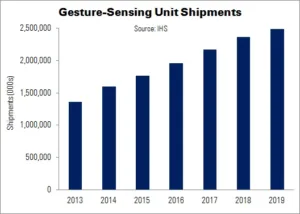Gesture-sensing control (‘gesture control’) user interface shipments are forecast to rise 10% YoY this year, to 1.8 billion units. IHS says that touchscreen technology is not suitable for some new and emerging applications, such as smartwatches, VR games and smart TVs, so gestures could fill a growing gap in the market.
“Gesture-sensing control will not compete with touch screens, but will instead be complementary, because each technology is appropriate for specific applications”, said Calvin Hsieh of IHS. “Smart TVs, for example, are not good candidates for touchscreens, because they are too far from viewers. On the other hand, gesture-sensing control is especially suitable for future immersive augmented reality and virtual reality computing”.
66% of sensor shipments for game console applications will be represented by optical 3D depth-sensing technologies this year. These will include time of flight, stereo vision and structured light for freehand gesture control.
Due to Intel promoting Realsense, gesture control with 3D depth-sensing capabilities is expected to rise 43% this year. It will overtake 2D webcam technology in notebook PCs. Apple TV is likely to take on the structured light technology that it acquired from Primesense. Such a move would boost gesture-sensing control for smart TV applications by 35%.
“Mainstream consumers have been aware of gesture-sensing control since the debut of the Nintendo Wii in 2006”, said Hsieh. “Now, almost a decade later, gesture-sensing control is poised to become the second-most-common user interface for smart devices after touch screens. It will take time, however, to develop even more creative and useful apps that rely on gesture sensing, and change users’ in-grained, touch-screen-centric behaviours”.

